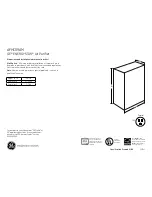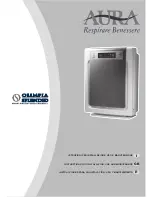
ENGLISH
(Original instructions)
7
tions, etc.
♦
Ensure that the appliance is level with respect to the
floor.
♦
The appliance requires suitable ventilation in order to
work properly. Leave a space of 50cm between walls or
other obstacles.
♦
Do not cover or obstruct any of the openings of the
appliance.
♦
Do not cover or obstruct the sides of the appliance,
and leave a minimum space of 50cm front other walls,
ceiling.
♦
The plug must be easily accessible so it can be discon-
nected in an emergency.
♦ To achieve the highest efficiency from the appliance it
should be situated in a place where the atmospheric
temperature is between 12 and 32ºC.
♦
Ensure that the extraction pipe remains in a horizontal
position.
♦
Do not add new sections to the extraction tube provided,
as it could cause the appliance to malfunction.
♦
Assemble the hose adaptor. Don´t push too hard to
prevent damage.
♦
Assembly of the exhaust hose
♦
Lengthen one head of the hose, screw it into the unit
anti-clockwise.
♦
The same way to connect the hose to the assembled
adaptor( At least three circles)
Assembling the battery/s
♦
Caution: During the handling of batteries, do not touch
both poles at the same time, as this will provoke the
partial discharge of the stored energy therefore affecting
longevity.
♦
Remove the cover of the battery compartment.
♦
Check that the plastic covering that protects the battery
has been removed (some batteries are sold with a
protective covering)
♦
Put the battery in its compartment, respecting the
polarity.
♦
Replace the cover of the battery compartment.
♦
It is essential that the batteries should always be the
same kind and the same charge. Never mix alka-
line batteries with normal one (Carbon-Zinc) and/or
rechargeable ones.
Installation of window kits.
♦ Partially open the window and then fix the window kits
to the window
♦
The window kits can be installed on most normal and
vertical windows, and it is adjustable. (Fig.1)
♦
Fix the other end of the heat-exhausted hose to the
air-outlet window kit. (Fig.2)
INSTRUCTIONS FOR USE
Before use:
♦ Remove the appliance’s protective film.
♦
Before using the unit, please keep it upright at least 2
hours.
Use:
♦
Unroll the cable completely before plugging it in.
♦
Connect the appliance to the mains.
♦
You will hear a beep, the unit is in stand by status.
♦
When press the ON/OFF button, the unit will enter in
cooling mode (setting temperature 24ºC), high speed
fan.
♦
Press again , unit will shut off and play shut off beep.
♦
Press the MODE button to choose Cooling, Heating
(only for the model BXAC12000E) Fan or dehumidifying
mode.
Fan speed:
♦
Under the cooling and the fan mode, the speed goes as
follow:
♦ Low Fan (F1)→Middle Fan (F2)→High Fan (F3)→Low
Fan (F1)
♦
Under the dehumidifying mode, fan is working in low
speed.
Timer function:
♦
The appliance’s operating time can be controlled.
♦
To program the operating time simply select it using
pressing the timer icon.
♦ Timer icon will flash “88” area indicates 24:00.
♦
You can set your time through UP and DOWN buttons.
♦
The HOUR number will change from 1-24h.
♦
Auto-shut-off timer is only available when the unit on.
♦
Auto-run timer is only available when the unit is off.
♦
Up and Down button can set temperature and timer.
Swing:
♦
Press this button to control the swing function.
Summary of Contents for BXAC12000E
Page 1: ...FR EN DE IT ES PT NL PL EL RU RO BG www blackanddecker eu BXAC12000E...
Page 2: ...A6 A5 A1 A7 A2 A3 A7 A B C D E F G I J K L M P N O 5 M M C C F F 4 3 6 2 1...
Page 3: ...Fig 1 Fig 2...
Page 114: ...114 BXAC12000E Black Decker 14 5 m2 R290 300 R290 R290...
Page 115: ...115 8 50 cm 50 cm T 250VAC 3 15A...
Page 116: ...116 16 30 mA...
Page 119: ...119 BXAC12000E BXAC12000E 3 FL LCD standby 10 on off pH 2...
Page 120: ...120 3 E1 E2 FL...
Page 122: ...122 R290 CO2...
Page 123: ...123 LFL 25...
Page 124: ...124 OFN OFN OFN OFN OFN a b c d e f g h...
Page 125: ...125 80 i j k GG 2 GG 4...
Page 126: ...126 GG 5 IEC 6007915 2010 5 5...
Page 127: ...127 5...
Page 128: ...128 BXAC12000E Black Decker 14 5 2 R290 300 R290 R290...
Page 129: ...129 8 50 50 T 250 3 15...
Page 130: ...130 16 30 H...
Page 131: ...131 A B C D E F G I J K L M N O P A1 On Off A2 A3 A5 A6 A7 1 2 3 4 5 6 50 50 12 32 C...
Page 132: ...132 Fig 1 Fig 2 2 ON OFF 24 C BXAC12000E F1 F2 F3 F1 88 24 00 1 24 16 30 C A2 2 A7 6 A3 3...
Page 133: ...133 BXAC12000E BXAC12000E FL 10 ON OFF 2 A1...
Page 134: ...134 pH 3 E1 E2 FL...
Page 136: ...136 R290 CO 2...
Page 137: ...137...
Page 138: ...138 LFL 25 OFN OFN OFN OFN OFN a b c d e f g h 80...
Page 139: ...139 i j k GG 2...
Page 140: ...140 GG 4 GG 5 IEC 6007915 2010 5...
Page 141: ...141 5 5...
Page 156: ...156 BXAC12000E Black Decker 14 5 m2 R290 300 R290 R290...
Page 157: ...157 8 50 50 250VAC 3 15A...
Page 158: ...158 16 c a pa o a a e c po c a epe c 30 mA...
Page 159: ...159 A B C D E F G I J K L M N O P A1 ON OFF A2 A3 A5 A6 A7 1 2 3 4 5 6 50 50 12 C 32 C...
Page 161: ...161 3 FL Stand by 10 On Off pH 2...
Page 162: ...162 3 E1 E2 FL U...
Page 164: ...164 R290 CO2...
Page 165: ...165...
Page 166: ...166 LFL 25 OFN OFN OFN 0 OFN OFN a b c d e...
Page 167: ...167 f g h 80 i j k...
Page 168: ...168 GG 2 GG 4 GG 5 IEC 60079 15 2010 5...
Page 169: ...169 5 5...








































